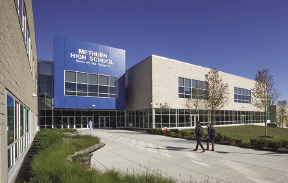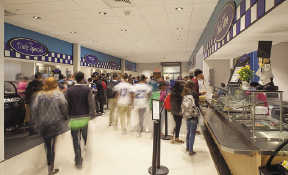Prior to 2011, the city of Methuen was in an educational ‘crisis’ of sorts – Methuen High School’s cavernous 1970s open-classroom facility was in danger of losing its accreditation due to its dramatically inadequate teaching environment, including its lack of ADA design components. Putting the students’ needs first and assembling an effective School Building Committee comprised of key decision makers from the city proved to be the key to the success of the project.
After a long 5 year design and construction period, the city of Methuen now has a dynamic, beautifully designed educational space with expansive windows and skylights to allow for natural light and ventilation, the latest technology tools for learning and an energy efficient mechanical system.
The original, open-classroom design was award-winning and widely acclaimed in the 1970s. Unfortunately, the open design concept quickly proved to be non-functional for both educators and students. To try to rectify the situation, temporary partitions, some made from furniture, were installed in an effort to create individual classrooms, but little could be done to improve problems with circulation, lack of natural light, and ventilation. After almost 40 years of “making due” with the conditions, once the school’s accreditation was in jeopardy, the Methuen School Administration determined serious action needed to be taken.
The solution involved hiring adaptive use experts Finegold Alexander Architects to design an extensive renovation of the existing classroom wing and a new 105,000 s/f addition to house the media center, dining, auditorium, band and art studios. To oversee construction, Consigli was hired as the construction manager to execute an aggressive two phased, two-year construction schedule all while the building was occupied with students during the academic years. The project design began in 2009 and was ready to bid in 2011. Groundbreaking followed shortly that same year and the final phase was completed in 2014.
Why Re-use an Existing School Building
The most sustainable building is the one that already exists. Unlike many buildings from the 1960s and 1970s era, the existing Methuen High School had good bones (i.e. structure) and an expansive floor plate which allowed for reorganizing the floor plan without impacting the exterior envelope or roof. The more that could be retained of the existing building the less building waste going to a landfill.
The size of the existing building and a number of its programs, like the field house and ice rink, exceeded the current square footages allowed by MSBA (Mass. School Building Authority). If the district were to relocate elsewhere and build new, it would not have received funding for these program spaces. Therefore the city would have had a smaller school, and less space for some of the elements of the school that we were able to build into it – including a state-of-the-art auditorium which doubles as a teaching space and community performing arts center designed to seat 750 patrons.
While an extensive renovation can be complicated, the main components of the building - foundation, floor slabs, steel structure and exterior walls - could, for the most part, remain intact. Selective demolition of the slab, windows and roof was required to open up the center of the building for new skylights and larger windows, ultimately leading to the transformation of the building.
Ironically, the original “open-floor plan” design which worked against the educational philosophy of the school actually worked in favor of the renovation by essentially acting as a blank slate for reorganizing the plan to create enclosed classrooms and support spaces. The structural grid, set at 30’ intervals, was ideal for establishing classroom sizes that meet current day educational requirements.
Today, the city of Methuen has a 21st century educational facility with 16 science labs, a state-of-the-art teaching Auditorium, band and choral practice rooms, art studios and a new media center all housed within the existing building footprint constructed on-time and on-budget with little disruption to the students.
Lessons Learned:
Cities, towns or districts planning to re-use an existing building might benefit from some of the lessons the team learned during construction:
1. First, establishing a phasing plan is not just about shuffling spaces to make temporary classrooms. The entire MEP/FP building systems and the mechanical and electrical room locations must be accounted for so that the building can remain operational during construction.
2. Second, the building facilities department must play a key role in the renovation of an existing school to weigh in on the service and support aspects for the school. We involved this team more and more as we realized they were key to the success of the project.
3. There must be buy-in from the school department to support major changes to the existing school. The school department had to buy-in, and believe in the success early on.
4. The student’s educational experience is extremely important in considering how to renovate an existing, occupied building. All changes should be made ALWAYS with the students in mind. For example Finegold Alexander held a student charrette to get design ideas from the key users of the building.
5. Finally, transparency and meeting with the city/town goes a long way in gaining support for a major renovation project. The city of Methuen is large and varied and keeping the town informed became a major factor to our success.
The renovated space included 264,000 s/f of classrooms, science labs, admin/teacher support spaces, smaller break-out seminar rooms
The 105,000 s/f addition included new kitchen, cafeteria, auditorium, and fine arts educational spaces, including physical plant infrastructure. Working with the city of Methuen and, the construction management team of Consigli, and keeping students always at the forefront of our planning and phasing, made this a successful venture that has at last made this high school better than the original.
Regan Shields Ives, AIA, LEED AP, is a senior associate with Finegold Alexander Architects, Boston.
.png)









